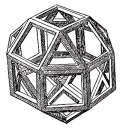Mind's eye
From The Art and Popular Culture Encyclopedia
(Difference between revisions)
| Revision as of 14:54, 28 March 2009 Jahsonic (Talk | contribs) ← Previous diff |
Revision as of 21:08, 19 June 2012 Jahsonic (Talk | contribs) Next diff → |
||
| Line 1: | Line 1: | ||
| {{Template}} | {{Template}} | ||
| The phrase "'''mind's eye'''" refers to the human ability for [[visualization]], i.e., for the experiencing of visual [[mental image|mental imagery]]; in other words, one's ability to "[[sight|see]]" things with the [[mind]]. | The phrase "'''mind's eye'''" refers to the human ability for [[visualization]], i.e., for the experiencing of visual [[mental image|mental imagery]]; in other words, one's ability to "[[sight|see]]" things with the [[mind]]. | ||
| + | ==See also== | ||
| + | * [[Mental image]] | ||
| + | * [[Philosophy of perception]] | ||
| + | * [[Subjective character of experience]] | ||
| + | * [[Third eye]] | ||
| + | * [[Binding problem]] | ||
| + | * [[Visual perception]] | ||
| + | * [[Nous]] | ||
| + | |||
| {{GFDL}} | {{GFDL}} | ||
Revision as of 21:08, 19 June 2012
|
Related e |
|
Featured: |
The phrase "mind's eye" refers to the human ability for visualization, i.e., for the experiencing of visual mental imagery; in other words, one's ability to "see" things with the mind.
See also
- Mental image
- Philosophy of perception
- Subjective character of experience
- Third eye
- Binding problem
- Visual perception
- Nous
Unless indicated otherwise, the text in this article is either based on Wikipedia article "Mind's eye" or another language Wikipedia page thereof used under the terms of the GNU Free Documentation License; or on research by Jahsonic and friends. See Art and Popular Culture's copyright notice.

